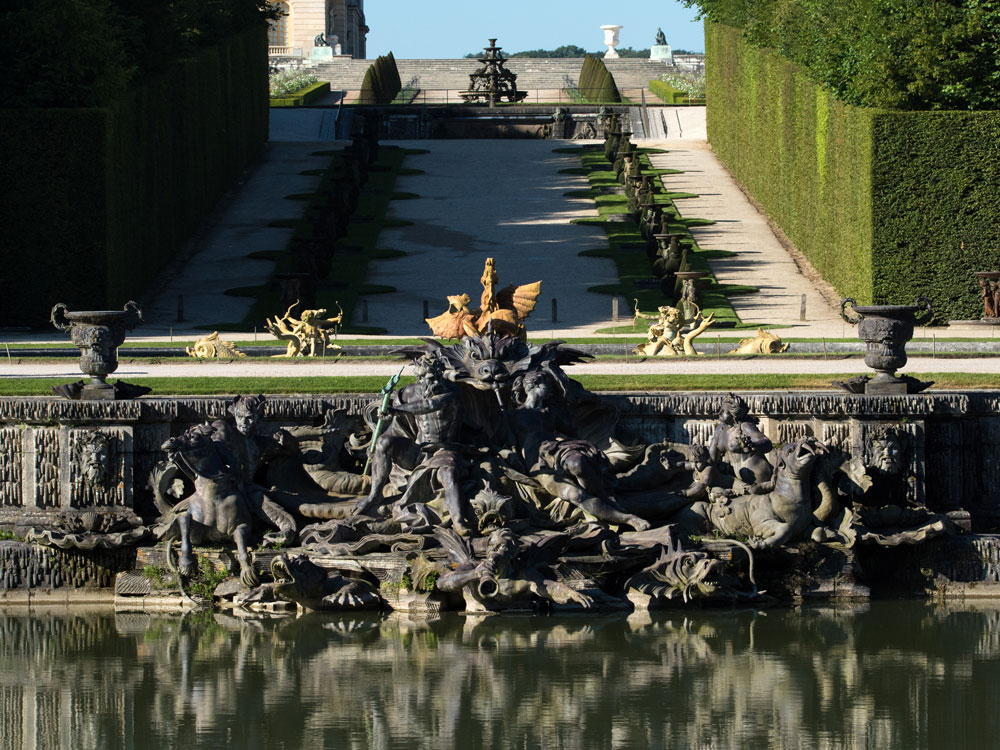the four seasons fountains

The Palace garden is designed around alleys running parallel or perpendicular to the Royal Way and marking out groves. At the four crossroads of the principle alleys stand four fountains, built in the 1670s and dedicated to the four seasons. The Spring Fountain or Flora Fountain (1674) and the Summer Fountain or Ceres Fountain (1673) are to the north, while to the south are the Autumn Fountain or Bacchus Fountain (1674) and the Winter Fountain or Saturn Fountain (1677). From a viewpoint at the end of Latona’s Parterre and the entrance to the Royal Way all four fountains can be admired at once.
fountains of the fight of the animals

West of the Water Parterre and on either side of the central axis are two fountains designed by Jules Hardouin-Mansart, made in 1687. They are composed of fighting animals and demonstrate impressive realism. To the north, the Diana or Evening Fountain features a lion bringing down a wolf (by Cornelius Van Cleve) and a lion bringing down a wild boar (by Jean Raon); to the south, the Daybreak Fountain features a tiger bringing down a bear and a bloodhound bringing down a stag (by Jacques Houzeau). In each piece, the water jet of the victorious animals falls into the upper basin, while the jet of the defeated animals falls into the lower basin.
dragon fountain

The Water Walk ends in a semi-circle at the Dragon Fountain. This piece represents an episode from the legend of Apollo, in which the serpent Python was killed by an arrow shot by the young Apollo. The reptile is surrounded by dolphins and Loves armed with bows and arrows and riding swans. The main water jet reaches a height of 27 metres and is the tallest among the fountains in the gardens of Versailles. On either side of the fountain, whose central sculptural group was reproduced in 1889, are alleys leading to two groves: France Victorious to the south and the Three Fountains to the west.
neptune fountain

The Neptune Fountain was made between 1679 and 1682 and its construction was overseen by Le Nôtre. At the time it was called the Lake below the Dragon Fountain, or Lake of the Pines. The original design consisted of marine decoration on the theme of Neptune, but the large groups planned were never built during the reign of Louis XIV. During the following reign, the shape of the pool was modified slightly in 1736 by Ange-Jacques Gabriel and in 1740 it was given its definitive sculpted features composed of three groups: Neptune and Amphitrite by the Lambert brothers, Proteus by Edme Bouchardon, and Oceanus by Jean-Baptiste Lemoyne. The new fountain was officially opened by Louis XV and was greatly admired for the number, size and variety of water jets falling around the lead sculptures. It currently has 99 jets, constituting an extraordinary hydraulic system.
Latona's fountain

Latona’s fountain was inspired by The Metamorphoses by Ovide. It illustrates the story of Latona, the mother of Apollo and Diana, protecting her children from the insults of the peasants of Lycia and pleading with Jupiter to avenge her. The god obliges by turning the inhabitants of Lycia into frogs and lizards.
The central marble group was sculpted by the Marsy brothers and features Latona and her children. When the fountain was first created in 1668 it was originally placed on a rock surrounded by six figures of peasants in mid-transformation, with 24 frogs positioned on the strip of lawn surrounding the fountain. At the time the goddess was looking towards the Palace. This layout was modified by Jules Hardouin-Mansart between 1687 and 1689. The rock was replaced by a marble pyramid and the group containing Latona was turned to face the Grand Canal. Latona’s Fountain also has a parterre containing the two Lizard Fountains.
apollo's fountain

A water feature already existed here in 1636, during the reign of Louis XIII, and was known as the Lake of the Swans. Louis XIV later added the spectacular and famous work in gilded lead of Apollo riding his chariot. This piece, built by Tuby on a design by Le Brun, is based on the legend of Apollo, the Sun god and the King’s icon. It features the god bursting forth from the water in anticipation of his daily flight above the earth. Tuby made this monumental group in the Gobelins manufacture between 1668 and 1670, when it was transported to Versailles and put in place and gilded the following year.
mirror pool
The Mirror Pool was dug in 1672 to complement the large Royal Isle Fountain opposite, now the King’s Grove. The two pools were separated by an alley. Le Nôtre made use of the difference in ground level to site the Royal Isle Fountain below the Mirror Pool, by designing the retaining wall between them in a series of cascading architectural features.
nymphs' bath
Also known as Diana’s Nymphs’ Bath, this pool collects the water from the Pyramid Fountain. It is decorated with bas-reliefs, the most famous of which, by Girardon (1668-1670), is on the retaining wall and is made of lead, at one time gilded. The others were made by Le Gros, Le Hongre and Magnier.












